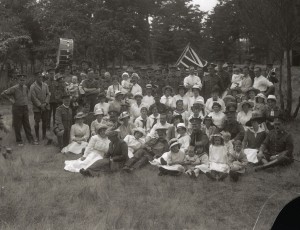Being British
*Le contenu de cette page n’est pas encore disponible en français. Veuillez accepter nos excuses. Nous espérons vous offrir plus de matériel en français dès que possible.
To view documents in the digital archive about race click here
The first non-Indigenous settlers to British Columbia were mainly transient male labourers who worked in the fur trade, mined coal in Nanaimo, or travelled to the Fraser River in search of gold. Some of these men were British but many were Chinese, Hawaiian, or African American. British officials, however, controlled much of the early economy, asserting British dominance over the budding colony. In part, the early assertion of British identity in B.C. was a response to the racially diverse labouring class, as well as the Aboriginal population, which far outnumbered settlers at the time.[1]
As settlement of the West continued during the late nineteenth century, those already living in B.C. encouraged the image of “British”

Note the prominent place of the Union Jack in this image from a wartime picnic. Image Courtesy of Esquimalt Archives. Judy Chamberlain Collection, 12.
Columbia. The orchards of the Okanagan, for example, were compared by local companies to the pre-industrial English countryside.[2] Institutions like private schools and the militia, which celebrated English heritage and fostered an exclusive social culture, also promoted British identity.[3]
The cultivation of British identity was particularly strong in Victoria. In 1908, a writer for the London’s Times newspaper wrote, “Victoria is the most ‘English’ of all the towns of Canada. The society of the place largely consists of Englishmen and Englishwomen of the better classes, and the English element is conspicuous in the clubs.”[4] The English character of Victoria was a draw for some immigrants who looked to continue or improve upon their respectable social standing after moving to B.C.[5]
The years before the First World War saw a solidification of racial boundaries that emphasized difference and encouraged hostility towards the non-British residents of Victoria.[6] In 1912, British Columbia’s Premier Richard McBride stated that “British Columbia must be kept white…we have the right to say that our own kind and color shall enjoy the fruits of our labour.”[7] McBride focused particularly on disallowing Chinese and Japanese immigration to British Columbia. Despite widespread support for the exclusion of non-white immigrants, Victoria was not purely British but much more racially diverse. The city was a hub of industry and culture, in which people of diverse backgrounds worked, lived, and interacted. Three of the most prominent non-British populations in Victoria during the First World War were :
Chinese Victorians and Chinatown during WWI
Coast and Straits Salish Peoples in Victoria
Germans in Victoria
By Ashley Forseille
[1] Adele Perry, “Introduction,” On the Edge of Empire: Gender, Race, and the Making of British Columbia, 1849-1871 (Toronto: University of Toronto Press, 2001), 1-19.
[2] Jean Barman, “Unpacking English Gentlemen Emigrants’ Cultural Baggage: Apple Orchards and Private Schools in British Columbia’s Okanagan Valley,” British Journal of Canadian Studies 16.1 (2003); Jason P. Bennett, “Apple of the Empire: Landscape and Imperial Identity in Turn-of-the Century British Columbia,” Journal of the Canadian Historical Association 9.1 (1998): 63-92.
[3] James A. Wood, “Social Club Or Martial Pursuit? The BC Militia before the First World War,” B.C. Studies 173 (2012), 41-68; Jean Barman, Growing Up British in British Columbia: Boys in Private School (Vancouver: UBC Press, 1984), 3.
[4] Times, 3 January 1908 as cited by Barman, Growing Up British in British Columbia,18.
[5] Barman, Growing Up British in British Columbia, 18.
[6] Patricia Roy, White Man’s Province: B.C. Politicians and Chinese and Japanese Immigrants, 1858-1914 (Vancouver: UBC Press, 1988); Patricia Roy, The Oriental Question: Consolidating a White Man’s Province, 1914-41 (Vancouver: UBC Press, 2003).
[7] As cited by Roy, White Man’s Province, 229.
Sources:
Barman, Jean. Growing Up British in British Columbia: Boys in Private School. Vancouver: UBC Press, 1984.
Barman, Jean. “Unpacking English Gentlemen Emigrants’ Cultural Baggage: Apple Orchards and Private Schools in British Columbia’s Okanagan Valley.” British Journal of Canadian Studies 16.1 (2003).
Bennett, Jason P. “Apple of the Empire: Landscape and Imperial Identity in Turn-of-the Century British Columbia.” Journal of the Canadian Historical Association 9.1 (1998): 63-92.
Perry, Adele. On the Edge of Empire: Gender, Race, and the Making of British Columbia, 1849-1871. Toronto: University of Toronto Press, 2001.
Roy, Patricia. White Man’s Province: B.C. Politicians and Chinese and Japanese Immigrants, 1858-1914. Vancouver: UBC Press, 1988.
Roy, Patricia. The Oriental Question: Consolidating a White Man’s Province, 1914-41. Vancouver: UBC Press, 2003.
Wood, James A. “Social Club Or Martial Pursuit? The BC Militia before the First World War.” B.C. Studies 173 (2012): 41-68.